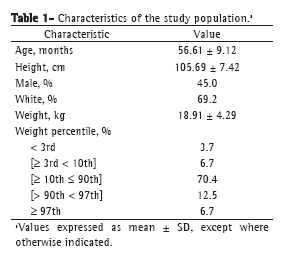

Edjane Figueiredo Burity, Carlos Alberto de Castro Pereira, José Ângelo Rizzo, Emanuel Sávio Cavalcanti Sarinho, Marcus Herbert Jones
ABSTRACT
Objective: To evaluate the acceptability and reproducibility of spirometry in preschool children; to estimate the effect size of early termination of exhalation (ETE) on FVC, FEV1 and FEV0.5; and to evaluate the validity of FEV0.5 in curves with ETE. Methods: Spirometric data were obtained from 240 healthy preschool children, who were selected by simple sampling. On the basis of the best curve from each child according to the end of exhalation, three groups were formed: no ETE (nETE); ETE and flow ≤ 10% of the highest PEF (ETE≤10); and ETE and flow > 10% of the highest PEF value (ETE>10). The reproducibility of FVC, FEV1 and FEV0.5 was compared among the three groups. The effect of ETE on FVC, FEV1, and FEV0.5 was assessed. Results: Of the 240 children tested, 112 (46.5%)-82 (34.0%) of those in the nETE group and 30 (12.5%) of those in the ETE≤10 group-had acceptable curves for all the parameters. In 64 (27.0%) of those in the ETE>10 group, the curves were acceptable only for FEV0.5, increasing the proportion of children with valid FEV0.5 to 73.0%. There were no significant differences between the nETE and ETE≤10 groups in terms of the mean values of the parameters assessed. Conclusions: Maneuvers with ETE and flow ≤ 10% of the highest PEF are valid. In individuals with a flow > 10% of the highest PEF value, these maneuvers are only valid for FEV0.5.
Keywords: Spirometry; Child, preschool; Vital capacity; Forced expiratory volume; Reproducibility of results.
RESUMO
Objetivo: Avaliar a aceitabilidade e a reprodutibilidade da espirometria em pré-escolares; estimar o tamanho do efeito da terminação precoce da expiração (TPE) nos valores de CVF, VEF1 e VEF0,5; e avaliar a validade do VEF0,5 em curvas com TPE. Métodos: Espirometrias foram obtidas em 240 pré-escolares saudáveis, selecionados por amostragem simples. Três grupos foram formados com base na melhor curva de cada criança de acordo com o término da expiração: sem TPE (sTPE); com TPE e fluxo ≤ 10% do maior PFE (TPE≤10); e com TPE e fluxo > 10% do maior PFE (TPE>10). Foram comparadas a reprodutibilidade da CVF, VEF1 e VEF0,5 nos três grupos. Foi avaliado o efeito da TPE em CVF, VEF1 e VEF0,5. Resultados: Das 240 crianças testadas, 112 (46.5%) realizaram curvas aceitáveis para todos os parâmetros - 82 (34,0%) no grupo sTPE e 30 (12,5%) no grupo TPE≤10. Em 64 (27,0%) no grupo TPE>10, as curvas foram aceitáveis apenas para VEF0,5, aumentando para 73,0% a proporção de crianças com VEF0,5 válido. Não houve diferenças significantes nas médias dos parâmetros avaliados entre os grupos sTPE e TPE≤10. Conclusões: Manobras com TPE e fluxo ≤ 10% do maior PFE são válidas. Em indivíduos com fluxo > 10% do maior PFE, essas manobras são válidas somente para VEF0,5.
Palavras-chave: Espirometria; Pré-escolar; Capacidade vital; Volume expiratório forçado; Reprodutibilidade dos testes.
Introduction



